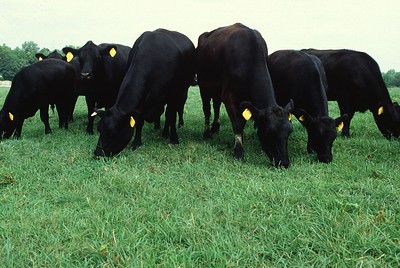Beef Cattle

Importance of Beef Cattle to Oregon
Cattle have been raised in Oregon since 1824. Currently, cattle are raised in all 36 counties. Oregon has 525,000 head of beef cows and 1,250,000 head of cattle and calves. Cattle and calves ranked as Oregon’s number 2 commodity in 2020, with total sales of about $587 million. The top Oregon counties for raising cattle are Malheur, Klamath, Harney, Baker, and Lake.1
History of Beef Cattle
Not long ago, cattle were used for many purposes including meat, milk, and labor. Today, beef cattle are still raised to provide meat, as well as hundreds of useful byproducts.
Most beef cattle graze on grassland that is steep, hilly, dry, or rocky; not suitable for building houses or growing crops. The main reason beef cattle are raised in different climates and settings all over the world is that they can thrive on low-quality feed and grasses.
Cattle are descended from a wild ancestor called the aurochs. The aurochs were huge animals that originated on the subcontinent of India and then spread into China, the Middle East, and eventually northern Africa and Europe. Aurochs are one of the animals painted on the famous cave walls near Lascaux, France. People started domesticating aurochs between 8,000 and 10,000 years ago. Cattle were domesticated after sheep, goats, pigs, and dogs.
Cattle were first brought to the western hemisphere by Columbus on his second voyage to the New World in 1493. Spanish explorer Hernando Cortez took the offspring of the same cattle to Mexico in 1519. In 1773, Juan Bautista de Anza brought 200 head of cattle to California to supply the early California missions.2
Beef Cattle Breeds
There are numerous breeds of beef cattle raised in the United States. Some breeds have been around for centuries, while others have been developed in the last couple of decades by mixing older breeds. Each breed is characterized by different traits such as size, weather tolerance, color, markings, hair length and temperament.
There are two classifications: Bos indicus and Bos taurus. Bos taurus includes British and Continental. British breeds, also known as English breeds, are smaller in size than Continental breeds. These breeds are the foundation of the U.S. beef herds. Common English breeds include Angus, Red Angus, Shorthorn and Hereford. Continental breeds, also called Exotics, originated in Europe. They are larger, lean, muscular and can tolerate hot climates. Continental breeds include Charolais, Limousin, Simmental and Salers.
Bos indicus are humped cattle originating from South Central Asia. They are adapted to the stresses of heat, humidity, parasites, and poorly digestible forages. Bos indicus breeds are often found in the southern United States. Common Bos indicus breeds are Brahman, Brangus, Beefmaster, Simbrah and Santa Gertrudis. Some common breeds found in Oregon include:
Tagging, Branding & Earmarks
Newborn calves are commonly tagged. Each ear tag has an individual number which helps ranchers pair the mother with their young and track the calf through its life cycle. Within the first few months of their lives, the calves will be branded.
A brand is an identification mark for cattle. It can either be a hot iron brand or a freeze brand. Some operations use earmarks, as an additional way to identify their cattle. During branding, all calves are vaccinated to help prevent disease. The young male calves are castrated during the first few months. After castration, they are referred to as steers.

Cattle's Amazing Stomachs
Cattle are ruminants. This means they have one stomach with four separate compartments. Their digestive system allows them to digest plant material by repeatedly regurgitating it and chewing it again as cud. This digestive process allows cattle to thrive on grasses, other vegetation and feed. Cattle chew their cud for about eight hours a day. When an animal chews its cud, it is a sign of health and contentment. Other ruminant animals include deer, elk, sheep and goats.
Beef Nutrition
Beef is a nutritionally rich food and a source of essential nutrients. A three-ounce serving of lean beef contributes to more than 10% of the daily recommended value of protein, zinc, vitamin B12, selenium, phosphorus, choline, niacin, vitamin B6, iron, and riboflavin.
Some common types of lean beef cuts include sirloin steak, rib-eye steak, T-Bone and tenderloin steak. The U.S. Department of Agriculture’s Nutrient Database shows that many cuts of beef are 20% leaner than they were 15 years ago. Half of the fatty acids found in beef are monounsaturated, the same healthy fat found in olive oil.
Beef Byproducts
Besides meat and milk, cattle provide us with hundreds of important byproducts. Almost the entire beef animal can be used in some way.
Beef byproducts are anything made from a beef animal other than meat. You probably use more beef byproducts than you think! Some edible examples include margarine, gelatin and marshmallows. Non-edible byproducts include leather, soap, cosmetics, crayons and buttons. Cattle also contribute to the health industry. Here are some examples.
Bone, Horn, Hooves and Gelatin: combs, gelatin candy (Gummy Bears), photographic film, steel ball bearings, fine bone china, pet food and vitamin capsules/gel coatings.
Hide and Hair: insulation, paintbrushes, glue for bookmaking and band-aides, clothes, shoes, luggage, saddles, furniture, automobiles, volleyballs, basketballs and baseball gloves.
Fats and Fatty Acids: shampoo, shaving creams, deodorants, candles, crayons, floor wax, detergents, hydraulic brake fluid, plastics, insecticides, paints, perfumes and synthetic rubber.
Vocabulary Terms
Auroch
The ancient ancestor of domesticated cattle.
Beef Byproducts
Anything made from a beef animal other than meat.
Brand
An identification mark on cattle; either hot iron or freeze brand.
Breed
A group of animals that have the same ancestry and characteristics.
Calf
A young animal, either male or female, less than one year.
Castration
To remove the testicles of male cattle.
Cud
The portion of food that an animal regurgitates to chew for the second time.
Earmark
Identification tool where part of the ear is removed to show ownership.
Forages
Plant material, mainly leaves and stems, eaten by livestock.
Polled
Born without horns, naturally hornless.
Regurgitation
Controlled flow of stomach contents back into the throat and mouth.
Roan
An even mixture of white and pigmented hairs, normally red or black.
Ruminants
Mammals that chew cud and have a complex, usually four-chambered stomach.
Steer
A young male calf which has been castrated before reaching sexual maturity. Steers are usually raised for beef.
